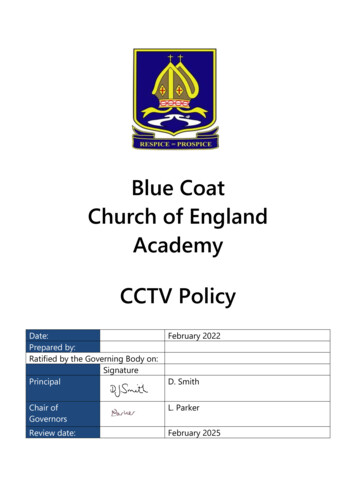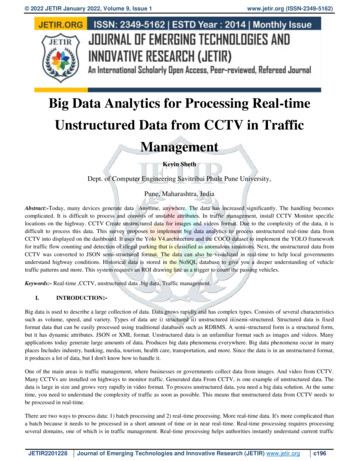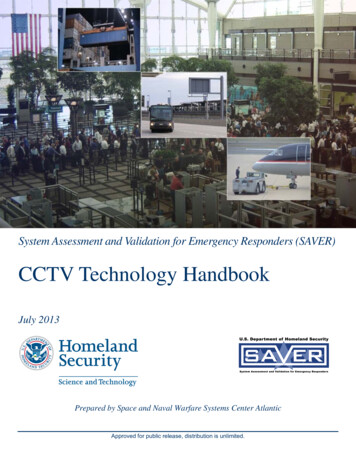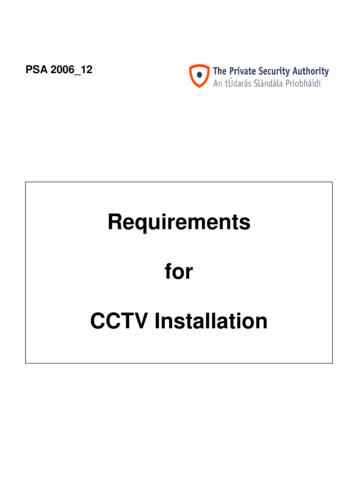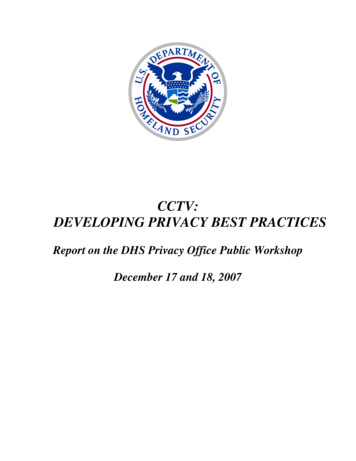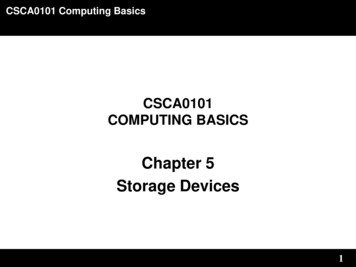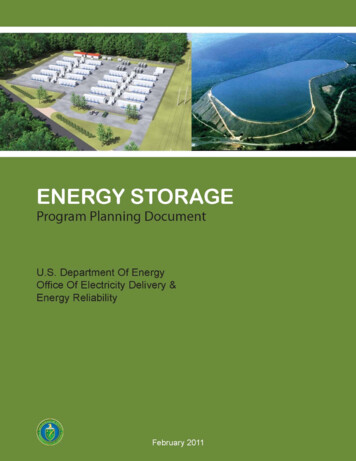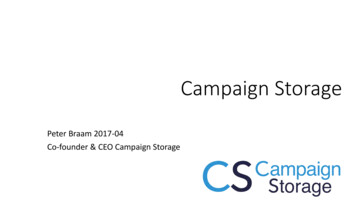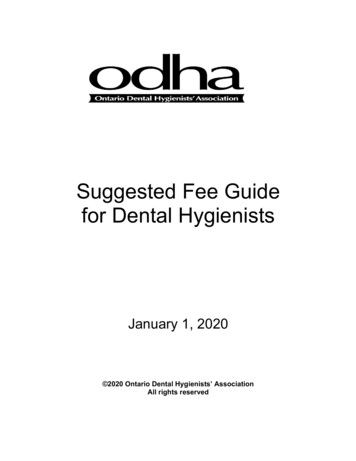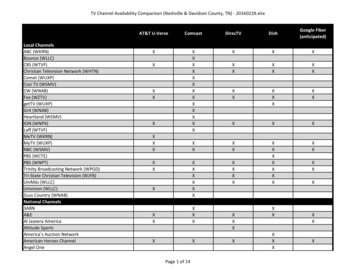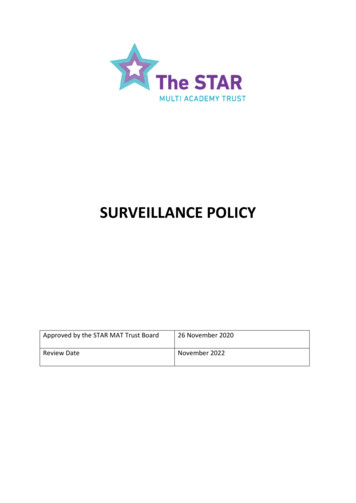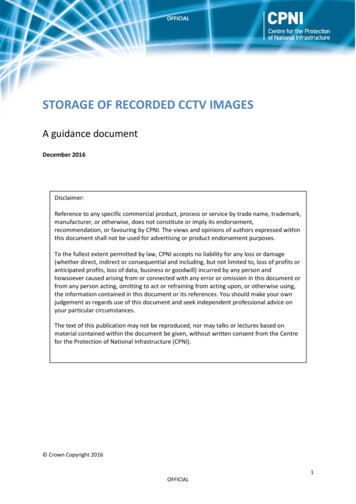
Transcription
OFFICIALSTORAGE OF RECORDED CCTV IMAGESA guidance documentDecember 2016Disclaimer:Reference to any specific commercial product, process or service by trade name, trademark,manufacturer, or otherwise, does not constitute or imply its endorsement,recommendation, or favouring by CPNI. The views and opinions of authors expressed withinthis document shall not be used for advertising or product endorsement purposes.To the fullest extent permitted by law, CPNI accepts no liability for any loss or damage(whether direct, indirect or consequential and including, but not limited to, loss of profits oranticipated profits, loss of data, business or goodwill) incurred by any person andhowsoever caused arising from or connected with any error or omission in this document orfrom any person acting, omitting to act or refraining from acting upon, or otherwise using,the information contained in this document or its references. You should make your ownjudgement as regards use of this document and seek independent professional advice onyour particular circumstances.The text of this publication may not be reproduced, nor may talks or lectures based onmaterial contained within the document be given, without written consent from the Centrefor the Protection of National Infrastructure (CPNI). Crown Copyright 20161OFFICIAL
OFFICIALPROTECTIVE MARKING ContentsAim . . 2Background . 2What should we be recording? . 3What should we be storing? . 3Using Stored Imagery . 3Examples . 4Summary . . 5Further Reading . 5AimThe aim of this document is to provide guidance to assist organisations in establishing how long theyshould store recorded CCTV images. This document should be used for guidance only. Some sectorshave their own regulatory bodies and this document does not aim to contradict mandatedregulations.BackgroundMany organisations deploy CCTV in a surveillance scenario. They record the imagery and store it for avariable length of time. CPNI have concluded that there are a lot of misconceptions andmisunderstandings about what imagery should be recorded and how long those recordings should bekept. There appears to be a misconception that the Home Office states that 30 days is mandatory –this is not true!. Or that an organisation can make an arbitrary ‘finger in the wind’ type decision onhow long they hold images. This decision can be based on a number of things, not least the cost ofstorage! To an extent this is true an organisation can (and should) make its own mind up about howlong images are kept but this decision needs to be qualified and documented.2OFFICIAL
OFFICIALPROTECTIVE MARKING What should we be recording?The principles of siting/using a surveillance camera (which in essence a security camera is) arecentred around the use of cameras in a responsible way. Each and every camera should have astated purpose. That purpose will be identified through the Operational Requirement (OR) process.The OR for CCTV is owned by the Home Office. It should be understood why the camera is there,what it is looking at and why and what will be done with the recorded images. The SurveillanceCamera Code of Practice (Home Office, 2013) sets out quite clearly the 12 guiding principles behindthe use of CCTV.What should we be storing?There is a belief in the security world that CCTV imagery should be stored for a mandated period(typically 30 days). However, there is no set time for holding CCTV recorded imagery1. TheSurveillance Camera Code of Practice (Home Office, 2013) states:‘No more images and information should be stored than that which is strictly required for the statedpurpose of a surveillance camera system, and such images and information should be deleted oncetheir purposes have been discharge’2.Obviously, each site will have a specific requirement and should be able to identify the storageperiod during the OR process. By following the OR, a documented trail will naturally be created. Thisprocess will mean that the site or organisation is not in breach of legislation or the code of practice.It will also ensure that a site is not unnecessarily spending money on storage that is not required.There is NO set time forstoring imagesUsing Stored ImageryStored CCTV imagery must be treated in confidence. Everyone has a right to privacy (even in thework place). Some of your recorded imagery may be of the general public and the vast majority offootage will be of law abiding people going about their business. We have a duty to look after thisinformation.‘Access to retained images and information should be restricted and there must be clearly definedrules on who can gain access and for what purpose such access is granted; the disclosure of imagesand information should only take place when it is necessary for such a purpose or for lawenforcement purposes’3.1Certain sectors will have their own regulations which should be adhered to, if applicableSurveillance Camera Code of Practice (Home Office, 2013, guidance principle 6 refers)3Surveillance Camera Code of Practice (Home Office, 2013, guidance principle 7 refers)23OFFICIAL
OFFICIALPROTECTIVE MARKING Given the citation above, an organisation must periodically review the imagery for two reasons.1. Firstly, it is important to ensure that the recorded imagery is of a quality that is of some useif and when it is required.2. Secondly, it is good practice to check footage for signs of hostile reconnaissance taking place.The person(s) responsible for the review must be a trusted member of staff and the recordings mustbe kept in confidence.Recorded images MUSTbe protectedExamplesThere are a number of CCTV deployments which may require imagery to be stored for varyinglengths of time.1. Imagine a small shop. It has two CCTV cameras operating 24 hours a day and recording theimagery. The risk to this store is from shoplifting during opening hours and break in duringthe closed period. It could be argued that there is no need to record more than 24 hours offootage. If the shopkeeper comes to work in the morning and there has been no break inthen the footage is no longer needed. There may also be an argument that for evidence ofshoplifting longer storage time may be needed. That is a decision to be made followingconsultation with the police . Suffice to say that 30 days of recorded images is not requiredand is in not in the spirit of the Surveillance Camera Code of Practice (Home Office, 2013).2. A transport hub has deployed a CCTV solution in and around the site. There are a number ofcameras on the outside of the building monitoring the movements of the general public. Itmight be appropriate given location, threat assessment etc. for images to be stored for inexcess of 30 days. This figure will be arrived at in the OR stage from consultation withstakeholders including the police perhaps. A longer period of storage might be required forpost-event analysis or for proactive searches for hostile reconnaissance.3. A government site is installing a CCTV system. They have a regulating body who mandate 90days CCTV recording. The site MUST comply with the regulator and it is for the regulator tojustify the reasons behind the 90 days mandatory time.4OFFICIAL
OFFICIALPROTECTIVE MARKING SummaryAlthough, generally, there are no hard and fast rules for the retention of recorded CCTV imagery it isfair to say that footage should only be stored for as long as is absolutely necessary to meet the OR.This footage must be treated in confidence by trained and trusted staff and should only be used forauthorised and documented purposes and deleted once it is no longer required.There are certain sectors who will have the storage time mandated by governing bodies orregulators. These regulations will take precedence over all other guidance and good practice.Further ReadingSurveillance Camera Code Of Practice (Home Office, 2013) and associated documents available -camera-code-of-practiceSurveillance Camera Commissioner Self-Assessment Tool available -camera-code-of-practice-self-assessment-toolCCTV Operational Requirement Manual (Home Office, 2009) tachment data/file/378443/28 09 CCTV ORManual2835.pdf5OFFICIAL
There are certain sectors who will have the storage time mandated by governing bodies or regulators. These regulations will take precedence over all other guidance and good practice. Further Reading Surveillance Camera Code Of Practice (Home Office, 2013) and associated documents available at:
